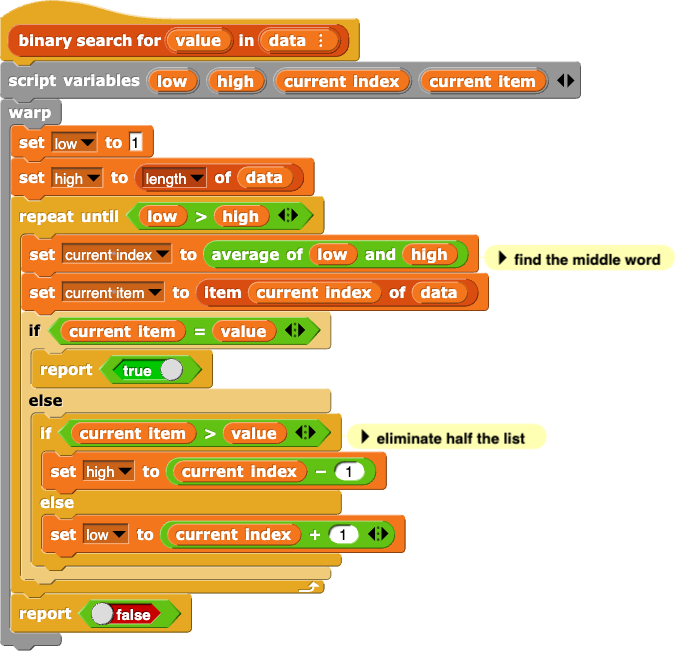 . But "simple" doesn't mean fast. The
. But "simple" doesn't mean fast. The contains block still has to look at each item in the list until it finds the one you are looking for (and says true) or reaches the end of the list (and says false). It is still a linear search.On this page, you will use a binary search algorithm to search efficiently in a sorted list.
Answering this question is simple in Snap! because you can just ask a dictionary:  . But "simple" doesn't mean fast. The
. But "simple" doesn't mean fast. The contains block still has to look at each item in the list until it finds the one you are looking for (and says true) or reaches the end of the list (and says false). It is still a linear search.
When you are only looking for one thing in a list (for example, checking whether a particular word is spelled correctly) rather than finding all the words with some characteristic (for example, looking for all five-letter words), you can use the strategy from Page 1: Guess My Number to make your algorithm faster. The best strategy for that problem is a binary search algorithm: always guess the middle value and then adjust your guess based on whether it was too high or too low. That way, you eliminate half the possibilities with each guess. We can use a similar strategy to look for a word in a word list.
A binary search algorithm starts in the middle of a sorted list and repeatedly eliminates half the list until either the desired value is found or all elements have been eliminated.
Linear search does a complete traversal of the list. Binary search saves time by doing a partial traversal of the list.
binary search block with your code from Page 1: Guess My Number. What parts are the same? What parts are different?
> block (as well as the < and = blocks) compares words alphabetically: 

binary search to look for the word in the sorted list .png) .
.binary search with some words that you know are spelled correctly and some that you know are incorrect. binary search: Try it with some words that you know are spelled correctly and some that you know are incorrect." --MF, 7/13/20binary search to search for the same words in the unsorted 100,000 words.The contains block can't make any assumptions about the ordering in list you are searching, but if you are looking for one thing in a sorted, list you can use binary search.
Two things affect whether you can use a binary search algorithm to make your program more efficient:
| find one value | find many values | |
|---|---|---|
| sorted data | can use binary search | must use linear search |
| unsorted data | must use linear search | must use linear search |
 to convert the input text into a list.
to convert the input text into a list.